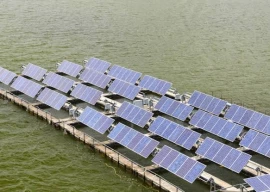"The SBP is keeping the interest rate unchanged due to contained inflation and strong economic growth," announced SBP Governor Tariq Bajwa at a press conference.
Bajwa, who has recently joined the central bank, however, pointed out that the external economic sector posed challenges like the widening current account deficit and falling worker remittances.
The central bank has kept the discount rate unchanged at 5.75% since May 2016, which is the lowest level in four decades. The rate was in double digits at 10% in the first half of fiscal year 2012-13.
At the start of 2017-18, three features of Pakistan's economy stand out than the rest.
First, average inflation is expected to remain below the target of 6% mainly on the back of favourable supply conditions.
"The SBP is projecting average CPI inflation in the range of 4.5-5.5% for FY18. This projection is explained by lower-than-anticipated increase in international oil prices, recent behaviour of CPI inflation in June 2017, stable prices and lower inflationary expectations," said Bajwa.
Second, domestic demand is set to gain further traction as reflected in current growth in the real sector, credit to private sector and imports.
Third, on the external front, the underperformance of both exports and worker remittances greatly affected the current account deficit, which reached $12.1 billion in FY17.
Monetary Policy: SBP leaves interest rate unchanged at 5.75%
"The first two features show that the economy is on an expansionary phase, while the third feature highlights near-term balance of payments challenges," Bajwa said.
LSM, agronomy outperform
The Large-scale Manufacturing (LSM) sector depicts a strong positive growth and momentum with food, especially sugar, steel, cement, automobiles, electronics and pharmaceuticals in the lead.
The sector grew 5.7% during July-May against 3.4% during the same period last year.
Furthermore, the outcome of agriculture sector is far better than in FY16, reaching its target of 3.5% in FY17. This performance is explained by better supply of factors of production, positively impacting yields of all major crops, and an increase in area under sugarcane cultivation.
The services sector posted a 6% increase in FY17 compared to 5.5% rise in FY16.
"Going forward, these developments will further entrench in FY18," said the governor.
Credit flow at a decade high
The market has seen a strong credit demand from the private sector. "Increased economic activity, considerable increase in bank deposits and low interest rates translated into private sector credit flows in FY17, reaching a decade high of Rs748 billion compared with Rs446 billion in FY16," he said.
Demand for consumer financing, especially for auto and personal loans, also gathered pace during FY17.
"These trends are set to continue in FY18 given the developments on the real side," the SBP chief added.
Exports bottom out
On the external trade front, the current account deficit reached $12.1 billion during FY17. While exports and worker remittances declined, import growth surged 17.7%.
This is mainly owing to machinery imports both for CPEC and non-CPEC energy and infrastructure projects, whereas imports for plant up-gradation under the ongoing export package for the textile sector also added pressure.
"However, in view of the last four-month performance, the decline in exports appears to have bottomed out," he said.
SBP reserves drop $2b
The current account deficit has been managed by utilising foreign exchange reserves and a financial account surplus, which reached $9.6 billion during FY17 from $6.8 billion last year.
"SBP's foreign exchange reserves declined to $16.1 billion at the end of FY17 compared to $18.1 billion in FY16."
Going forward, global projections paint a positive outlook with both growth and international trade picking up in FY18.
Based on this assessment coupled with positive domestic policy measures, Pakistan's exports are expected to post gains.
Imports, on the other hand, albeit at a slower pace, are also expected to grow in line with continuation of CPEC-related activities and improving economic growth.
While it remains uncertain whether remittances can return to a meaningful positive growth very soon, stability of the external account and instrumental reserve accumulation depends on timely inflow of budgeted bilateral and financial inflows in FY18 as well, he said.






1734899549-0/image-(16)1734899549-0-270x192.webp)


1734899716-0/image-(15)1734899716-0-270x192.webp)





1734778885-0/Untitled-(10)1734778885-0-270x192.webp)






COMMENTS
Comments are moderated and generally will be posted if they are on-topic and not abusive.
For more information, please see our Comments FAQ